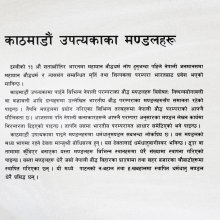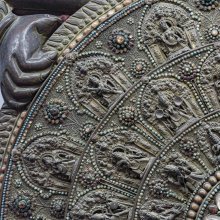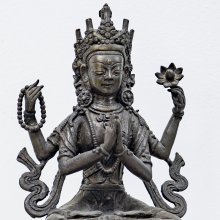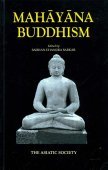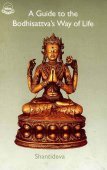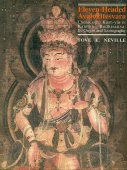Mahayana, Mahāyāna, Maha-yana: 14 definitions
Introduction:
Mahayana means something in Buddhism, Pali, Hinduism, Sanskrit. If you want to know the exact meaning, history, etymology or English translation of this term then check out the descriptions on this page. Add your comment or reference to a book if you want to contribute to this summary article.
Images (photo gallery)
(+29 more images available)
In Hinduism
Kavya (poetry)
Source: Wisdom Library: KathāsaritsāgaraMahāyāna (महायान) is the name of a Vidyādhara chief who, deserted the army of Śrutaśarman and took the side of Sūryaprabha, according to the Kathāsaritsāgara, chapter 48. Accordingly: “... we are named Mahāyāna and Sumāya, and this Siṃhabala was the third of us; we had obtained magic power by having the rule of a great cemetery, and were unassailable by the other Vidyādharas”.
The story of Mahāyāna was narrated by the Vidyādhara king Vajraprabha to prince Naravāhanadatta in order to relate how “Sūryaprabha, being a man, obtain of old time the sovereignty over the Vidyādharas”.
The Kathāsaritsāgara (‘ocean of streams of story’), mentioning Mahāyāna, is a famous Sanskrit epic story revolving around prince Naravāhanadatta and his quest to become the emperor of the vidyādharas (celestial beings). The work is said to have been an adaptation of Guṇāḍhya’s Bṛhatkathā consisting of 100,000 verses, which in turn is part of a larger work containing 700,000 verses.

Kavya (काव्य, kavya) refers to Sanskrit poetry, a popular ancient Indian tradition of literature. There have been many Sanskrit poets over the ages, hailing from ancient India and beyond. This topic includes mahakavya, or ‘epic poetry’ and natya, or ‘dramatic poetry’.
In Buddhism
Mahayana (major branch of Buddhism)
Source: Wisdom Library: Maha Prajnaparamita SastraMahāyāna (महायान) refers to a “great vehicle”, according to the 2nd century Mahāprajñāpāramitāśāstra chapter 46.—Accordingly, “Morality is the root of bliss for all beings. It is like a great treasure bringing pearls and jewels. Morality is a great protector that suppresses fears. It is like a great army that destroys thieves. Morality is an ornament to be worn like a necklace. Morality is a great ship capable of crossing the great ocean of saṃsāra. Morality is a great vehicle (mahāyāna) capable of transporting heavy jewels to the city of nirvāṇa. [...]”.
Source: Buddha World: MahāyānaMahāyāna (Sanskrit: महायान, mahāyāna, literally the “Great Vehicle”) is one of the two main existing branches of Buddhism and a term for classification of Buddhist philosophies and practice. Mahāyāna Buddhism originated in India.
The Mahāyāna tradition is the larger of the two major traditions of Buddhism existing today, the other being that of the Theravāda school. According to the teachings of Mahāyāna traditions, “Mahāyāna” also refers to the path of seeking complete enlightenment for the benefit of all sentient beings, also called “Bodhisattvayāna”, or the “Bodhisattva Vehicle.”
etymology: According to Jan Nattier, the term Mahāyāna (“Great Vehicle”) was originally an honorary synonym for Bodhisattvayāna (“Bodhisattva Vehicle”) — the vehicle of a bodhisattva seeking buddhahood for the benefit of all sentient beings. The term Mahāyāna was therefore formed independently at an early date as a synonym for the path and the teachings of the bodhisattvas. Since it was simply an honorary term for Bodhisattvayāna, the creation of the term Mahāyāna and its application to Bodhisattvayāna did not represent a significant turning point in the development of a Mahāyāna tradition.

Mahayana (महायान, mahāyāna) is a major branch of Buddhism focusing on the path of a Bodhisattva (spiritual aspirants/ enlightened beings). Extant literature is vast and primarely composed in the Sanskrit language. There are many sūtras of which some of the earliest are the various Prajñāpāramitā sūtras.
General definition (in Buddhism)
Source: Wisdom Library: Dharma-samgrahaMahāyāna (महायान) refers to the “great vehicle” and represents the third of the “three vehicles” (triyāna) defined in the Dharma-saṃgraha (section 2). The Dharma-samgraha (Dharmasangraha) is an extensive glossary of Buddhist technical terms in Sanskrit (e.g., triyāna and mahā-yāna). The work is attributed to Nagarguna who lived around the 2nd century A.D.
Source: Wisdom Library: BuddhismMahayana:—The greater vehicle teachings of the Buddha.
Source: archive.org: The Indian Buddhist Iconography (b)Mahāyāna (महायान) refers to one of the various Buddhist paths (yāna).—Lord Buddha prescribed Yānas in the beginning, namely, the Śrāvakayāna and the Pratyekabuddhayāna. [...] Buddhism continued in this state till the rise of the Mahāyāna properly called, the Bodhisattvayāna. [...] The Mahāyānists dismissed the previous Yānas with the contemptuous epithet of Hīnayāna. They claimed that they could not only attain Nirvāṇa, nay even Buddha-hood,with their own unaided efforts, but could also help others to attain these ideals. The distinction between Mahāyāna and Hīnayāna is graphically described in the earliest work, the Mahāyānasūtrālaṃkāra, attributed to the famous Buddhist sage Asaṅga.
Mahāyāna is mentioned as one of the three yānas in the Tattvaratnāvalī of Advayavajra (12th century A. D.):—“three are the Yānas, Śrāvakayāna, Pratyekayāna and Mahāyāna. There are four theories; Vaibhāṣika, Sautrāntika, Yogācāra and Madhyamaka. Śrāvakayāna and Pratyekayāna are explained by the theories of the Vaibhāṣikas. Mahāyāna is of two kinds: Pāramitānaya and Mantranaya. Pāramitānaya is explained by the theories either of Sautrāntika, Yogācāra or Madhyamaka. Mantranaya is explained by the theories of Yogācāra and Madhyamaka only”.
Source: Buddhist Door: GlossaryAlso called Great Vehicle or Bodhisattva Vehicle. It is a school of Buddhism prevalent in China, Korea, Japan, Mongolia, Tibet and other places in the Far East. It is also called Northern Buddhism. Mahayana is described as seeking Buddhahood and transforming beings, thus self benefiting for the benefits of the others. See also Hinayana. For further details, please refer to Section 3 A Glimpse in the Scope of Buddhism in Vol. 1 No. 4 of Budddhist Door. Source: WikiPedia: BuddhismMahayana is one of the two main existing schools of Buddhism and a term for classification of Buddhist philosophies and practice. It was founded in India.
(mahayana literally Great Vehicle)
The name Mahayana is used in three main senses:
- As a living tradition, Mahayana is the larger of the two major traditions of Buddhism existing today, the other being Theravada. This classification is largely undisputed by all Buddhist schools.
- According to the Mahayana scheme of classification of Buddhist philosophies, Mahayana refers to a level of spiritual motivation[1] (also known as Bodhisattvayana[2]). According to this classification, the alternative approach is called Hinayana, or Shravakayana. It is also recognized by Theravada Buddhism, but is not considered very relevant for practice.[3]
- According to the Vajrayana scheme of classification of practice paths, Mahayana refers to one of the three routes to enlightenment, the other two being Hinayana and Vajrayana. This classification is part of the teachings of Vajrayana Buddhism, and is not recognized by Mahayana and Theravada Buddhism.
Mahāyāna Skt., lit., “Great Vehicle”; one of the two great schools of Buddhism, the other being the Hīnayāna, “Small Vehicle.” The Mahāyāna, which arose in the first century CE, is called Great Vehicle because, thanks to its many-sided approach, it opens the way of liberation to a great number of people and expresses the intention to liberate all beings.
Hīnayāna and Mahāyāna are both rooted in the basic teachings of the historical Buddha Shākyamuni, but stress different aspects of those teachings. While Hīnayāna seeks the liberation of the individual, the follower of the Mahāyāna seeks to attain enlightenment for the sake of the welfare of all beings. This attitude is embodied in the Mahāyāna ideal of the bodhisattva, whose outstanding quality is compassion (karunā).
The Mahāyāna developed from the Hīnayāna schools of the Mahāsānghikas and Sarvāstivādins (Sarvāstivāda), which formulated important aspects of its teaching. From the Mahāsānghikas came the teaching, characteristic of the Mahāyāna, of the transcendent nature of a buddha, as well as the bodhisattva ideal and the notion of emptiness (shūnyatā ). Seeds of the trikāya teaching can be recognized in the doctrine of the Sarvāstivādins.
The Mahāyāna divided into a series of further schools, which spread from India to Tibet, China, Korea, and Japan. In India arose the Mādhyamika school, founded by Nāgārjuna, and the Yogāchāra school, founded by Asanga. Parallel to the development of Tantra in Hinduism, in Buddhism also a magic-oriented school appeared, the Vajrayāna, which today flourishes primarily in Tibetan Buddhism.
The most important Mahāyāna schools in China were Ch’an, Hua-yen, T’ien-t’ai, and the Pure Land school. These schools were further developed in Japan as Zen, Kegon, Tendai, and Amidism, respectively.
The teachings of the Mahāyāna are contained in the Mahāyāna sūtras and shāstras, among which are some of the most profound writings of Buddhism.
Languages of India and abroad
Sanskrit dictionary
Source: DDSA: The practical Sanskrit-English dictionaryMahāyāna (महायान).—Name of the later system of Buddhist teaching, firstly promulgated by Nāgārjuna (opp. hīnayāna).
Derivable forms: mahāyānam (महायानम्).
Mahāyāna is a Sanskrit compound consisting of the terms mahā and yāna (यान).
Source: Cologne Digital Sanskrit Dictionaries: Edgerton Buddhist Hybrid Sanskrit DictionaryMahāyāna (महायान).—nt., the ‘Great Vehicle’ (also called bud- dha-, bodhisattva-yāna, qq.v., and see yāna, vajra- yāna, agrayāna): passim, e.g. Mahāvyutpatti 1250; bhikṣur °naṃ dhārayamāṇaḥ Suvarṇabhāsottamasūtra 192.1; kecin °nam abhiśraddhayanti id.8.
Source: Cologne Digital Sanskrit Dictionaries: Monier-Williams Sanskrit-English Dictionary1) Mahāyāna (महायान):—[=mahā-yāna] [from mahā > mah] n. ‘great vehicle’ (opp. to hīna-y), Name of the later system of Buddhist teaching said to have been first promulgated by Nāgārjuna and treated of in the Mahā-yāna-sūtras, [Monier-Williams’ Buddhism 66; 158-160 etc.]
2) [v.s. ...] m. ‘having a gr° chariot’, Name of a king of the Vidyādharas, [Kathāsaritsāgara]
[Sanskrit to German]
Sanskrit, also spelled संस्कृतम् (saṃskṛtam), is an ancient language of India commonly seen as the grandmother of the Indo-European language family (even English!). Closely allied with Prakrit and Pali, Sanskrit is more exhaustive in both grammar and terms and has the most extensive collection of literature in the world, greatly surpassing its sister-languages Greek and Latin.
Kannada-English dictionary
Source: Alar: Kannada-English corpusMahāyāna (ಮಹಾಯಾನ):—
1) [noun] a big carriage or vehicle.
2) [noun] one of the two major divisions of Buddhism (the other being Hīnayāna).
Kannada is a Dravidian language (as opposed to the Indo-European language family) mainly spoken in the southwestern region of India.
See also (Relevant definitions)
Starts with: Mahayanabhidharmasamgitishastra, Mahayanadeva, Mahayanaparigrahaka, Mahayanaprabhasa, Mahayanaprasadaprabhavana, Mahayanasamgraha, Mahayanasamparigrahashastra, Mahayanasutra, Mahayanasutraratnaraja, Mahayanayogashastra.
Full-text (+4759): Mahayanaparigrahaka, Hinayana, Mahayanasutraratnaraja, Buddha Nature, Parigrahaka, Mahayanasamgraha, Mahayanayogashastra, Mahayanasamparigrahashastra, Mahayanaprabhasa, Mahayanadeva, Mahayanasutra, Avatamsaka Sutra, Nagarjuna, Bodhicitta, Mahayanabhidharmasamgitishastra, Vajrayana, Makayanam, Buddhayana, Bodhisattvacaryavatara, Great vehicle.
Relevant text
Search found 122 books and stories containing Mahayana, Mahāyāna, Maha-yana, Mahā-yāna; (plurals include: Mahayanas, Mahāyānas, yanas, yānas). You can also click to the full overview containing English textual excerpts. Below are direct links for the most relevant articles:
Maha Prajnaparamita Sastra (by Gelongma Karma Migme Chödrön)
The Non-existence of Time According to the Mahāyāna < [Part 1 - Mahāyānist list of the eighteen special attributes of the Buddha]
Appendix 3 - The forty-two letters of the Arapacana alphabet < [Chapter XLIII - The Pursuit of the Six superknowledges]
Buddha-nature (as Depicted in the Lankavatara-sutra) (by Nguyen Dac Sy)
1. Early period (c): The Mahāparinirvāna-sūtra < [Chapter 2 - The Buddha-Nature in the Tathāgatagarbha Literature]
Tathāgatagarbha Literature (Introduction) < [Chapter 2 - The Buddha-Nature in the Tathāgatagarbha Literature]
A Dictionary Of Chinese Buddhist Terms (by William Edward Soothill)
Folk Tradition of Bengal (and Rabindranath Tagore) (by Joydeep Mukherjee)
The Three Vehicles Of Buddhism (by Kensur Lobsang Chojor)
Lankavatara Sutra (by Daisetz Teitaro Suzuki)
Related products
(+1 more products available)
